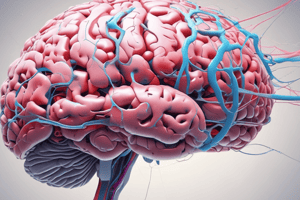Podcast
Questions and Answers
What is the main goal of deep brain stimulation (DBS) in treating Parkinson's disease?
What is the main goal of deep brain stimulation (DBS) in treating Parkinson's disease?
- To reduce severity of symptoms (correct)
- To restore dopamine production
- To completely cure Parkinson's disease
- To improve cognitive function
Which areas of the brain are typically targeted during the deep brain stimulation procedure?
Which areas of the brain are typically targeted during the deep brain stimulation procedure?
- Cortex and hippocampus
- Subthalamic nucleus and globus pallidus (correct)
- Amygdala and thalamus
- Hippocampus and medulla oblongata
How does the neurostimulator assist in the treatment of Parkinson's disease?
How does the neurostimulator assist in the treatment of Parkinson's disease?
- By releasing neurotransmitters directly into the bloodstream
- By blocking pain signals from reaching the brain
- By generating electrical impulses to regulate irregular brain activity (correct)
- By restoring blood flow to the brain
What type of imaging is used initially to identify treatment areas for deep brain stimulation?
What type of imaging is used initially to identify treatment areas for deep brain stimulation?
Which of the following is a characteristic of Parkinson's disease?
Which of the following is a characteristic of Parkinson's disease?
What role do PINK1 and PARKIN genes play in neurons?
What role do PINK1 and PARKIN genes play in neurons?
Which of the following is a consequence of excessive levels of Lewy Bodies?
Which of the following is a consequence of excessive levels of Lewy Bodies?
What is a long-term downside of using medications for treating Parkinson's Disease?
What is a long-term downside of using medications for treating Parkinson's Disease?
What is a significant surgical risk associated with Deep Brain Stimulation (DBS)?
What is a significant surgical risk associated with Deep Brain Stimulation (DBS)?
How does gut dysbiosis relate to Parkinson's Disease?
How does gut dysbiosis relate to Parkinson's Disease?
What is a characteristic of the batteries used in DBS systems?
What is a characteristic of the batteries used in DBS systems?
Which statement best summarizes the conclusion about DBS in the treatment of Parkinson's Disease?
Which statement best summarizes the conclusion about DBS in the treatment of Parkinson's Disease?
What results from gene dysfunction affecting mitochondria in neurons?
What results from gene dysfunction affecting mitochondria in neurons?
What is the purpose of Adaptive DBS (aDBS) in treating Parkinson's Disease (PD)?
What is the purpose of Adaptive DBS (aDBS) in treating Parkinson's Disease (PD)?
What is one of the major benefits of using Deep Brain Stimulation (DBS) for PD patients?
What is one of the major benefits of using Deep Brain Stimulation (DBS) for PD patients?
Which of the following factors can be adjusted in neurostimulators for DBS?
Which of the following factors can be adjusted in neurostimulators for DBS?
What causes the aggregation of misfolded α-synuclein in neurons leading to PD?
What causes the aggregation of misfolded α-synuclein in neurons leading to PD?
Which of the following is NOT a reported positive aspect of DBS for PD patients?
Which of the following is NOT a reported positive aspect of DBS for PD patients?
What are Lewy Bodies associated with in the context of Parkinson's Disease?
What are Lewy Bodies associated with in the context of Parkinson's Disease?
What is typically the best frequency setting for DBS to alleviate bradykinesia symptoms?
What is typically the best frequency setting for DBS to alleviate bradykinesia symptoms?
Which of the following is a potential negative aspect of using DBS?
Which of the following is a potential negative aspect of using DBS?
What is a major limitation of Deep Brain Stimulation (DBS) in treating Parkinson's disease?
What is a major limitation of Deep Brain Stimulation (DBS) in treating Parkinson's disease?
Which factor is associated with elevated gram-negative bacteria in Parkinson’s disease?
Which factor is associated with elevated gram-negative bacteria in Parkinson’s disease?
How can the progression of Parkinson's disease be potentially slowed?
How can the progression of Parkinson's disease be potentially slowed?
What is the relationship between postural unsteadiness and Parkinson's disease based on the information provided?
What is the relationship between postural unsteadiness and Parkinson's disease based on the information provided?
What are risk factors identified for Parkinson's disease?
What are risk factors identified for Parkinson's disease?
What does the term 'paradoxical effects' refer to in the context of DBS?
What does the term 'paradoxical effects' refer to in the context of DBS?
What additional research is suggested in relation to DBS treatment?
What additional research is suggested in relation to DBS treatment?
What role do endotoxins play in relation to Parkinson's disease?
What role do endotoxins play in relation to Parkinson's disease?
What condition is identified as increasing the risk of developing Parkinson's disease?
What condition is identified as increasing the risk of developing Parkinson's disease?
Which factor is mentioned in relation to the effectiveness of treatments for Parkinson's disease?
Which factor is mentioned in relation to the effectiveness of treatments for Parkinson's disease?
Which therapy is paired with catechol-O-methyltransferase inhibitors in treating Parkinson's disease?
Which therapy is paired with catechol-O-methyltransferase inhibitors in treating Parkinson's disease?
What characteristic is noted to have a higher risk of Parkinson's disease among individuals?
What characteristic is noted to have a higher risk of Parkinson's disease among individuals?
What type of study was referenced in relation to the long-term effectiveness of adjuvant treatments for Parkinson's disease?
What type of study was referenced in relation to the long-term effectiveness of adjuvant treatments for Parkinson's disease?
Which of the following treatment types is suggested to be less effective than dopamine agonists for Parkinson's disease?
Which of the following treatment types is suggested to be less effective than dopamine agonists for Parkinson's disease?
Which of the following is NOT mentioned as an intervention for Parkinson's disease?
Which of the following is NOT mentioned as an intervention for Parkinson's disease?
What is an occupational risk factor associated with Parkinson's disease?
What is an occupational risk factor associated with Parkinson's disease?
Flashcards
Deep Brain Stimulation (DBS)
Deep Brain Stimulation (DBS)
A surgical treatment for Parkinson's disease that involves implanting electrodes in specific brain areas to control abnormal brain activity.
Parkinson's Disease (PD)
Parkinson's Disease (PD)
A progressive neurological disorder causing movement problems due to dopamine loss in the brain.
Subthalamic Nucleus (STN)
Subthalamic Nucleus (STN)
A brain area often targeted for DBS in Parkinson's disease, involved in motor control.
Globus Pallidus Internal (GPi)
Globus Pallidus Internal (GPi)
Signup and view all the flashcards
Neurostimulator
Neurostimulator
Signup and view all the flashcards
α-synuclein mutations
α-synuclein mutations
Signup and view all the flashcards
Lewy bodies
Lewy bodies
Signup and view all the flashcards
Parkinson's Disease causes
Parkinson's Disease causes
Signup and view all the flashcards
Adaptive DBS (aDBS)
Adaptive DBS (aDBS)
Signup and view all the flashcards
DBS benefits
DBS benefits
Signup and view all the flashcards
DBS frequency
DBS frequency
Signup and view all the flashcards
DBS Adjustment
DBS Adjustment
Signup and view all the flashcards
Bradykinesia
Bradykinesia
Signup and view all the flashcards
Rigidity
Rigidity
Signup and view all the flashcards
Tremors
Tremors
Signup and view all the flashcards
Dyskinesia
Dyskinesia
Signup and view all the flashcards
Mitochondrial Dysfunction
Mitochondrial Dysfunction
Signup and view all the flashcards
Mitophagy
Mitophagy
Signup and view all the flashcards
Gut Dysbiosis
Gut Dysbiosis
Signup and view all the flashcards
What is the impact of elevated gram-negative bacteria?
What is the impact of elevated gram-negative bacteria?
Signup and view all the flashcards
What are paradoxical effects of DBS?
What are paradoxical effects of DBS?
Signup and view all the flashcards
Does DBS cure Parkinson's disease?
Does DBS cure Parkinson's disease?
Signup and view all the flashcards
What's the focus of alternative therapies for PD?
What's the focus of alternative therapies for PD?
Signup and view all the flashcards
What is the implication of DBS used alongside alternative therapies?
What is the implication of DBS used alongside alternative therapies?
Signup and view all the flashcards
What are the key takeaways regarding research and DBS?
What are the key takeaways regarding research and DBS?
Signup and view all the flashcards
What are the two primary factors contributing to PD?
What are the two primary factors contributing to PD?
Signup and view all the flashcards
What is the role of inflammation in PD?
What is the role of inflammation in PD?
Signup and view all the flashcards
Levodopa Therapy
Levodopa Therapy
Signup and view all the flashcards
Catechol-O-Methyltransferase (COMT) Inhibitors
Catechol-O-Methyltransferase (COMT) Inhibitors
Signup and view all the flashcards
Traumatic Brain Injury (TBI)
Traumatic Brain Injury (TBI)
Signup and view all the flashcards
Occupational Therapy
Occupational Therapy
Signup and view all the flashcards
Speech Therapy
Speech Therapy
Signup and view all the flashcards
Monoamine Oxidase B (MAO-B) Inhibitors
Monoamine Oxidase B (MAO-B) Inhibitors
Signup and view all the flashcards
Dopamine Agonists
Dopamine Agonists
Signup and view all the flashcards
Long-Term Effectiveness
Long-Term Effectiveness
Signup and view all the flashcards
Study Notes
Deep Brain Stimulation (DBS) in Parkinson's Disease
- DBS is a surgical treatment for Parkinson's disease, aiming to reduce symptom severity by implanting electrodes in specific brain areas.
- Parkinson's disease is a progressive neurological disorder, characterized by the loss of dopamine-producing neurons.
- DBS involves placing electrodes in areas like the subthalamic nucleus (STN) and globus pallidus (GPi), which are hyperactive in Parkinson's, and connecting them to a neurostimulator.
- The neurostimulator sends electrical impulses to regulate abnormal brain activity. This can help reduce tremors and other motor symptoms like rigidity, bradykinesia and dyskinesia.
Causes of Parkinson's Disease
- α-synuclein (SNCA) mutations can cause aggregation of misfolded α-synuclein, leading to Lewy bodies.
- Excessive Lewy bodies are toxic to dopamine-producing neurons.
- PINK1 and Parkin, genes that promote mitophagy (removing damaged mitochondria), are dysfunctional in the disease.
- Mitochondrial damage leads to oxidative stress and cell death
- Gut dysbiosis, an imbalance in the gut microbiome, has been linked to postural instability, which is associated with Parkinson's disease.
DBS: Positives and Negatives
- Positives:
- Effective in reducing tremors, rigidity and other motor symptoms of Parkinson's.
- Long-term solution, as its effects don't diminish like medications,
- Medication needs may be reduced
- Negatives:
- Surgical risks, including infection and bleeding, as well as complications during anesthesia
- Requires extensive hospitalization
- Non-rechargeable batteries require more surgery, which also introduces risks
- Paradoxical effects: constant production of electrical signals can disrupt normal brain activity.
Conclusion
- DBS is an effective long-term treatment option for Parkinson's, but especially for patients no longer responding to medications.
- It doesn't cure the disease; rather, it manages symptoms.
- Further research is needed to improve DBS effectiveness in the long-term.
Studying That Suits You
Use AI to generate personalized quizzes and flashcards to suit your learning preferences.
Related Documents
Description
This quiz explores the role of Deep Brain Stimulation (DBS) in managing Parkinson's disease symptoms. It covers the mechanism of DBS, the brain areas involved, and the underlying causes of Parkinson's disease, including genetic factors. Test your knowledge on this innovative treatment and its effects on motor symptoms.





